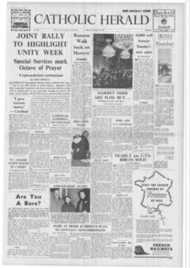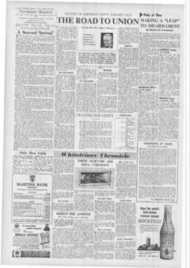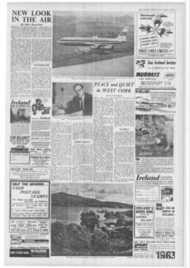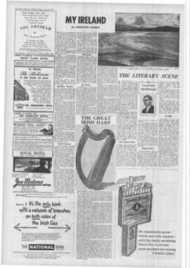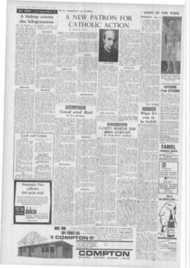Page 10, 18th January 1963
Page 10
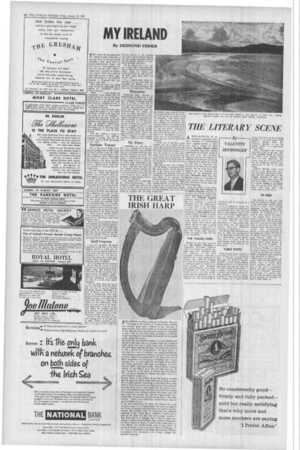
Report an error
Noticed an error on this page?If you've noticed an error in this article please click here to report it.
Tags
Share
Related articles
Irish Writing To-day
A Family View Of Literary Dublin
Beckett And Behan
A Martyr's Life
Pining With Religious Intent
THE LITERARY SCENE
By
VALENTIN IREMONGER
HOTCH-POTCH of re
miniscence, anecdote, ribaldry, snatches of remembered verse, original poems, a radio play and a couple of short stories, Brendan Behan's Island was probably the most noticed publication by an Irish writer in the past year. But Brendan, being sui generis, has little to do with the general scene of writing in Ireland and indeed he would be the first to excoriate any attempt to fit him into any such picture. So we must leave him weaving his way towards the ending of his promised new play, Richard's Cork Leg (the allusion being to a sentence in James Joyce's play, Exiles), and took elsewhere to see what has been happening.
Since the demise of the magazines The Bell, Irish Writing and the Dublin Magazine some five or six years ago, young writers have lacked somewhere to publish their work. The Kilkenny Magazine gallantly endeavoured to fill the gap but somehow a provincial magazine lacks the sophistication of those edited in the metropolis.
It was with a sense of relief, therefore, that one welcomed the foundation of The Dubliner (every second month) and the resuscitation of Poetry Ireland (twice a year). The latter is. of course, devoted entirely to poetry but the former prints short stories and critical articles as well as giving current poetry a good deal of attention. Both, I am happy to says like the young and unknown writer as much as they like the more established.
THE YOUNG ONES
During the year, there appeared also The Dolmen Miscellany, a substantial book-sized magazine which it is hoped to publish perhaps every year. Published with the assistance of the Irish Academy of Letters, it provides a platform for a new generation of writers who, while not forming any sort of movement. do reflect a general change of sensibility in Irish writing. John Montague and Thomas Kinsella, the editors, concentrate on "work of some length or of a kind not usually represented in magazines" in the hope that as well as providing an impetus. they will also provide "a record of work in progress by a generation."
It is an ambitious project but it can be said that the editors have accomplished their task well and give a representative cross-section of the work of the younger generation in Ireland. The over-all impression is that the new writers are more "lite:ary" than their predecessors — being more influenced more, say, by Joyce and Moore than by O'Connor, O'Faolain or O'Flaherty.
For the first time since its inception in 1940, the quinquennial A. E. Memorial Award was won by a prose-writer. John McGahern, and an extract from his prize-winning novel (due shortly from Faber) is included in the Miscellany.
THREE POETS
Three younger poets attracted a good deal of attention during the year — Thomas Kinsella, John Montague and Richard Murphy. Kinsella's second volume Downstream, appeared and, like his first four years ago, was the choice of the Poetry Book Society here — a unique achievement. His verse is poised and elegant and moves with assurance. In this volume, he seems to move towards dealing with themes of a more public
nature than those he has hitherto handled — his long poem, "Old Harry", dealing with Mr. • Truman's decision to use the atomic bomb, is a remarkable tour-de-force.
John Montague's first volume appeared earlier in the year. Entitled Poisoned Lands, its themes are drawn more directly from Irish life than Kinsella's. His poems grow out of rural Ireland and his childhood memories and observation of life in an Irish village.
Richard Murphy works more directly in the Anglo-Irish tradition than either Montague or Kinsella and his long poem on the Cleggan Disaster of 1927 was broadcast several times during the year by the BBC. It is included in his volume, Sailing to an Island (due this month from Faber) together with three other long poems and ten short lyrics.
IN IRISH
Yet fruitful as the year has been for writing in English, there is still much more activity among writers in Irish. Two monthly magazines of high quality exist, Comhar and Feasta, in which the standard of contribution is as good as what appears in English. The Gaelic Book Club continues to flourish with an expanding membership. The membership fee is £2 a year and for that small sum, it distributed last year one historical novel, one book of short stories, two autobiographical diaries, a scholarly biography of the nineteenth century revolutionary James Fintan Lalor and. for good measure, threw in two volumes of original poetry by two leading Gaelic poets. Mairtin 0 Direain and Sean 0 Tuama. 0 Direain, from the Aran Islands but living in Dublin, is easily the best poet writing in Irish and his work in its delicacy and sureness stands comparison with anything being produced in English.
Many other volumes appear. of course. other than the Book Club choices most of which show writers wrestling with the problems of the creative imagination equally with their contemporaries who write in English. They have the advantage of a certain audience and one genuinely interested in the progress of literature in Irish to spur them on.
blog comments powered by Disqus


